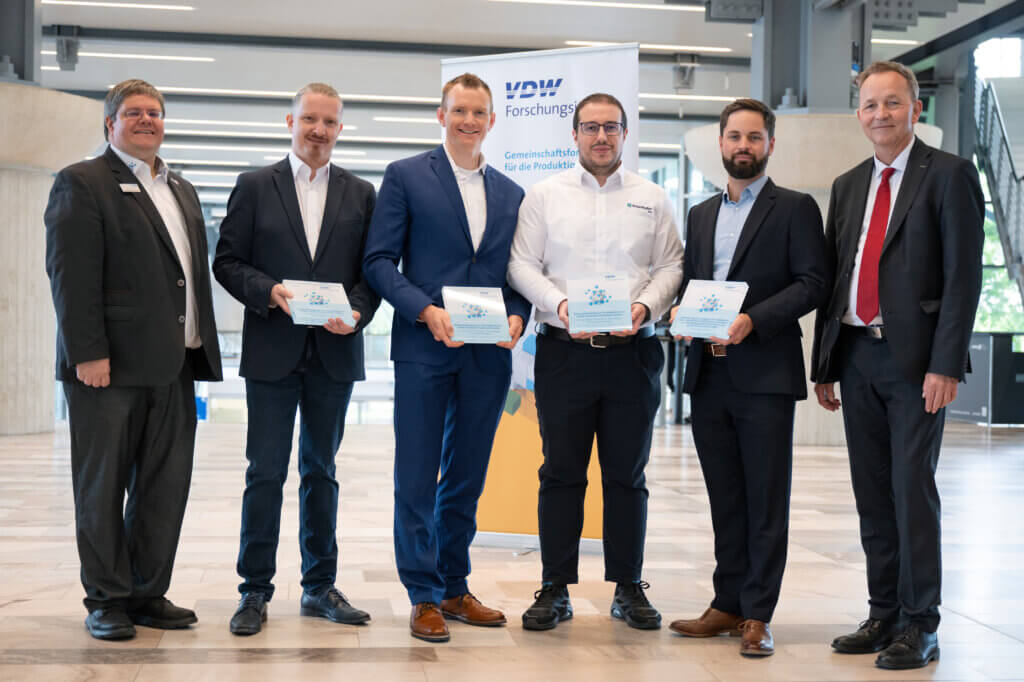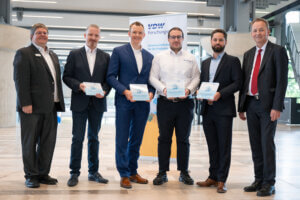Frankfurt am Main, October 14, 2025. – The EMO Hannover is the place where the international production technology community comes together. It is where all of the key industry representatives come together to discuss the latest developments, trends and research findings. Within the framework of this industry-leading trade fair, the VDW Research Institute has awarded prizes to two research projects as “Projects of the Year”. The awards were presented to the winners on Thursday, September 25, 2025, at the EMO Hannover trade fair by Dr. Stephan Kohlsmann, Chairman of the Executive Board of VDW-Forschungsinstitut, and its CEO Dr. Alexander Broos.
“With these awards, we want to specifically recognize the scientific staff of the research institutions involved in these kinds of project, as they generally dedicate themselves to the work for two to three years and achieve some amazing results,” said Dr. Broos, explaining the motivation for this unendowed, non-monetary prize.
Project of the Year 2024: Minimizing set-up times on forging hammers
Martin Wagner, Nico Wagner and Dr. Robert Tehel from the Fraunhofer Institute for Machine Tools and Forming Technology (IWU) in Chemnitz were awarded the prize for their project entitled “Minimizing set-up times on forging hammers using a sensitive die clamping system (sGs)”. The aim was to make tool changes on forging hammers more efficient, safer and more reproducible.
To this end, the researchers developed a measuring system that allowed the clamping situation to be recorded both qualitatively and quantitatively within the process for the first time. FEM simulations based on this data provided new insights into the clamping conditions. This ultimately led to the development of a new type of clamping system that can withstand the extreme dynamic and thermal loads in the forging process.
The solution offers significant advantages: shorter set-up times due to fewer readjustments, increased process reliability thanks to reproducible pretensioning and increased work safety, as uncontrolled hammer blows when driving in wedges are avoided. The concept also opens up new potential for automation and cost reduction. “With the newly developed measuring and clamping concept, companies can make their forging processes safer, more efficient and more economical. The data we obtained provides detailed insights into the actual clamping conditions for the first time and opens up new possibilities for automation,” explains Martin Wagner.
Sebastian Frank, Head of Development at Lasco Umformtechnik GmbH, Coburg, supported the project as a partner from the industry. “Tool mounting on forging hammers has remained essentially unchanged since the beginning of forging. It was therefore high time to investigate whether new technological methods could be used to gain knowledge that could be developed into practically applicable results, which would allow the highly efficient forging hammer to continue to meet ever more demanding customer requirements,” explained Mr. Frank. He is therefore delighted that, thanks to its strong practical focus, the project has been able to lay a foundation for the development of future systems.
Project of the Year 2023: Dimensioning of protective devices for grinding machines
The winner of the second project award was Simon Thom, who worked on a project entitled “Dimensioning of protective devices for stationary grinding machines” at the Institute of Machine Tools and Factory Management (IWF) at the Technical University of Berlin. The project focused on the question of how protective enclosures can be designed so that they reliably protect operating personnel and machines without being unnecessarily large.
Although burst testing carried out in the past was realistic, it was neither reproducible nor economical. The Berlin-based researchers therefore combined translational impact tests with finite element simulations. This resulted in a regression model that describes the relationship between grinding wheel parameters and the required wall thickness. It therefore became possible for the first time to develop well-founded and at the same time resource-saving specifications for the construction of protective devices.
The results have already been incorporated into the international standard ISO 16089. This makes CE marking easier for manufacturers, shortens approval processes and increases work safety. “The project is an example of the sustained and highly focused scientific work that is carried out at the IMF. In close cooperation with the machine tool manufacturers in the VDW and the BGHM trade association, we have carried out applied research that directly benefits practical applications,” emphasizes Simon Thom.
And Christian Adler from the Berufsgenossenschaft Holz und Metall (trade association for the woodworking and metalworking sectors) and chairman of the relevant standardization group adds: “As a trade association, our focus is on ensuring that occupational health and safety requirements are not only complied with, but also widely accepted. A sound scientific basis is essential for this. In this context, Mr. Thom’s outstanding project has made a significant contribution to the further development of dimensioning specifications for protective devices.”
The award-winning projects were funded by the German Federal Ministry for Economic Affairs and Energy as part of the “Industrial Collective Research” funding program.
Authors: Emelie Melchert / Dr. Alexander Broos, VDW
Background:
As a non-profit research association, the VDW-Forschungsinstitut e.V. collectively considers the needs of VDW member companies and other interested companies when they want to close knowledge gaps relating to machine tools, manufacturing technology or production engineering. Its focus is on pre-competitive industrial collective research (IGF), for which funding is obtained from the German Federal Ministry for Economic Affairs and Energy under the IGF program. In addition, the VDWFI supports numerous projects with its own funds financed by contributions and donations. To identify and support the variety of different topics, there are a total of eight topic-related working groups that look at different facets of process technology, machine development and general control-related or safety topics. This results in the development of networks, including networks of companies that are in competition with each other, allowing them to improve each other and work on new topics together. This collaboration on new and innovative topics strengthens both the industry and German SMEs in the metalworking sector as a whole.
Downloads
Award ceremony for the VDWFI “Project of the Year” at the EMO Hannover 2025. From left to right: Dr. Alexander Broos, Dr. Robert Tehel, Nico Wagner, Martin Wagner, Simon Thom, Dr. Stephan Kohlsmann. Source: Rainer Jensen / VDW


